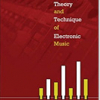Free Online Productivity Tools
i2Speak
i2Symbol
i2OCR
iTex2Img
iWeb2Print
iWeb2Shot
i2Type
iPdf2Split
iPdf2Merge
i2Bopomofo
i2Arabic
i2Style
i2Image
i2PDF
iLatex2Rtf
Sci2ools
193
click to vote
Book
The Theory and Technique of Electronic Music
"This is a book about using electronic techniques to record, synthesize, process,
and analyze musical sounds, a practice which came into its modern form in the
years 1948-1952, but whose technological means and artistic uses have undergone
several revolutions since then. Nowadays most electronic music is made
using computers, and this book will focus exclusively on what used to be called
computer music", but which should really now be called electronic music using
a computer".
Digital Filters | DSP | FFT | Fourier Transform | Modulator | Sampling Theorem | Signal Processing | Wavetable Oscillator |
Related Content
| Added | 05 Mar 2009 |
| Updated | 15 Mar 2009 |
| Authors | Miller Puckette |
Table of Content
1.1 Measures of Amplitude
1.2 Units of Amplitude
1.3 Controlling Amplitude
1.4 Frequency
1.5 Synthesizing a sinusoid
1.6 Superposing Signals
1.7 Periodic Signals
1.8 About the Software Examples
1.9 Examples
2.1 The Wavetable Oscillator
2.2 Sampling
2.3 Enveloping samplers
2.4 Timbre stretching
2.5 Interpolation
2.6 Examples
3.1 The sampling theorem
3.2 Control
3.3 Control streams
3.4 Converting from audio signals to numeric control streams
3.5 Control streams in block diagrams
3.6 Event detection
3.7 Audio signals as control
3.8 Operations on control streams
3.9 Control operations in Pd
3.10 Examples
4.1 Envelope Generators
4.2 Linear and Curved Amplitude Shapes
4.3 Continuous and discontinuous control changes
4.3.1 Muting
4.3.2 Switch-and-ramp
4.4 Polyphony
4.5 Voice allocation
4.6 Voice tags
4.7 Encapsulation in Pd
4.8 Examples
5.1 Taxonomy of spectra
5.2 Multiplying audio signals
5.3 Waveshaping
5.4 Frequency and phase modulation
5.5 Examples
6.1 Carrier/modulator model
6.2 Pulse trains
6.2.1 Pulse trains via waveshaping
6.2.2 Pulse trains via wavetable stretching
6.2.3 Resulting spectra
6.3 Movable ring modulation
6.4 Phase-aligned formant (PAF) generator
6.5 Examples
7.1 Complex numbers
7.1.1 Complex sinusoids
7.2 Time shifts and phase changes
7.3 Delay networks
7.4 Recirculating delay networks
7.5 Power conservation and complex delay networks
7.6 Artificial reverberation
7.6.1 Controlling reverberators
7.7 Variable and fractional shifts
7.8 Fidelity of interpolating delay lines
7.9 Pitch shifting
7.10 Examples
8.1 Taxonomy of filters
8.1.1 Low-pass and high-pass filters
8.1.2 Band-pass and stop-band filters
8.1.3 Equalizing filters
8.2 Elementary filters
8.2.1 Elementary non-recirculating filter
8.2.2 Non-recirculating filter, second form
8.2.3 Elementary recirculating filter
8.2.4 Compound filters
8.2.5 Real outputs from complex filters
8.2.6 Two recirculating filters for the price of one
8.3 Designing filters
8.3.1 One-pole low-pass filter
8.3.2 One-pole, one-zero high-pass filter
8.3.3 Shelving filter
8.3.4 Band-pass filter
8.3.5 Peaking and stop-band filter
8.3.6 Butterworth filters
8.3.7 Stretching the unit circle with rational functions
8.3.8 Butterworth band-pass filter
8.3.9 Time-varying coefficients
8.3.10 Impulse responses of recirculating filters
8.3.11 All-pass filters
8.4 Applications
8.4.1 Subtractive synthesis
8.4.2 Envelope following
8.4.3 Single Sideband Modulation
8.5 Examples
9.1 Fourier analysis of periodic signals
9.1.1 Periodicity of the Fourier transform
9.1.2 Fourier transform as additive synthesis
9.2 Properties of Fourier transforms
9.2.1 Fourier transform of DC
9.2.2 Shifts and phase changes
9.2.3 Fourier transform of a sinusoid
9.3 Fourier analysis of non-periodic signals
9.4 Fourier analysis and reconstruction of audio signals
9.4.1 Narrow-band companding
9.4.2 Timbre stamping (classical vocoder)
9.5 Phase
9.5.1 Phase relationships between channels
9.6 Phase bashing
9.7 Examples
10.1 Symmetries and Fourier series
10.1.1 Sawtooth waves and symmetry
10.2 Dissecting classical waveforms
10.3 Fourier series of the elementary waveforms
10.3.1 Sawtooth wave
10.3.2 Parabolic wave
10.3.3 Square and symmetric triangle waves
10.3.4 General (non-symmetric) triangle wave
10.4 Predicting and controlling foldover
10.4.1 Over-sampling
10.4.2 Sneaky triangle waves
10.4.3 Transition splicing
10.5 Examples
Comments (0)



